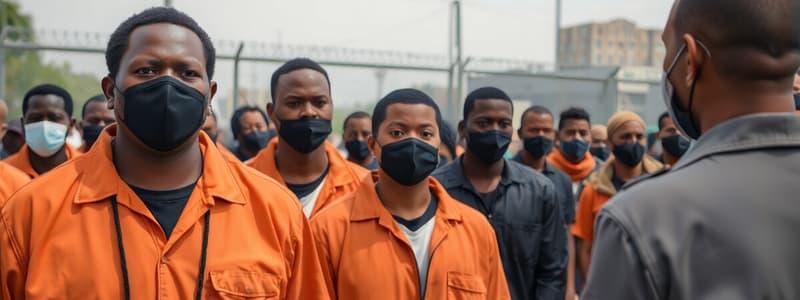Podcast
Questions and Answers
What is the primary focus when analyzing colorblindness?
What is the primary focus when analyzing colorblindness?
- The historical context of color vision research
- The genetic factors involved in colorblindness (correct)
- Environmental influences on color discrimination
- The impact of age on color perception
Which population is most likely to be affected by colorblindness?
Which population is most likely to be affected by colorblindness?
- Males, particularly those with a family history (correct)
- Children under the age of 10
- Elderly individuals over 70
- Females with no prior family cases
What type of colorblindness is characterized by difficulty distinguishing red and green hues?
What type of colorblindness is characterized by difficulty distinguishing red and green hues?
- Achromatopsia
- Monochromacy
- Trichromacy
- Dichromacy (correct)
How can colorblindness be diagnosed in individuals?
How can colorblindness be diagnosed in individuals?
What is a common misconception about individuals with colorblindness?
What is a common misconception about individuals with colorblindness?
Which of the following is a potential coping mechanism for those with colorblindness?
Which of the following is a potential coping mechanism for those with colorblindness?
What type of inheritance pattern is most commonly associated with colorblindness?
What type of inheritance pattern is most commonly associated with colorblindness?
What does the term 'Mass Incarceration' refer to?
What does the term 'Mass Incarceration' refer to?
Which social issue is highlighted as a consequence of mass incarceration?
Which social issue is highlighted as a consequence of mass incarceration?
What is one of the implications of 'The New Jim Crow' concept?
What is one of the implications of 'The New Jim Crow' concept?
How are law enforcement practices critiqued in relation to mass incarceration?
How are law enforcement practices critiqued in relation to mass incarceration?
What aspect of society does mass incarceration significantly affect?
What aspect of society does mass incarceration significantly affect?
What is a common misconception about mass incarceration?
What is a common misconception about mass incarceration?
Which factor is often cited as a contributing factor to the rise of mass incarceration?
Which factor is often cited as a contributing factor to the rise of mass incarceration?
What does the term 'The New Jim Crow' imply about contemporary society?
What does the term 'The New Jim Crow' imply about contemporary society?
Flashcards are hidden until you start studying
Study Notes
The New Jim Crow
- Mass incarceration is a new system of racial and social control in the United States.
- This system is based on the idea of colorblindness.
- Colorblindness refers to the idea that race should not be a consideration in law or policy.
- However, the consequences of mass incarceration disproportionately affect people of color.
- The War on Drugs played a key role in the expansion of the prison system, leading to an increase in mass incarceration.
- The War on Drugs has been used as a pretext to target people of color.
- The War on Drugs has been used to justify the racial profiling and criminalization of people of color.
- These policies have resulted in mass incarceration, which has created lasting consequences for people of color.
- This system has been referred to as The New Jim Crow, referring to the historical system of racial segregation and disenfranchisement in the United States.
- This system has created a permanent undercaste of people of color who are denied full citizenship and equal rights.
- The New Jim Crow is a system of racial and social control that continues to have devastating consequences for people of color.
Studying That Suits You
Use AI to generate personalized quizzes and flashcards to suit your learning preferences.




